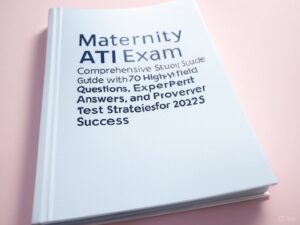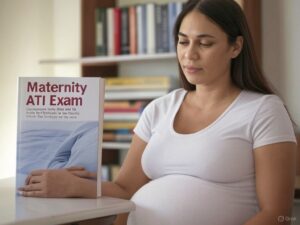Unlock your potential with the Maternity ATI Exam: Comprehensive Study Guide, your go-to resource for mastering the 2025 Maternal ATI Exam. This guide features 70 high-yield questions, expert answers, and proven test strategies to ensure your success in maternal and newborn nursing. Tailored for nursing students and professionals, it covers essential topics like prenatal care, labor and delivery, postpartum care, and neonatal health, all aligned with the latest 2025 ATI exam standards. Each question is paired with detailed, expert-verified answers and strategic insights to enhance your understanding and test-taking skills. Perfect for NCLEX prep, ATI testing, and maternal nursing certification, this study guide equips you with the knowledge and confidence to excel. Prepare effectively, tackle the exam with ease, and advance your nursing career with this indispensable resource for 2025 success.
Preview
1. Which of the following assessment findings in an infant should indicate to a nurse
that suctioning of the nasopharynx is needed?
A) The infant is beginning to cough
B) The newborn’s pulse oximetry is 91%
C) The infant’s respiratory rate is 32/min
D) The infant’s respiratory rate is irregular
Correct Answer: A) The infant is beginning to cough
Rationale: Coughing is an early sign of airway obstruction and indicates the need for
suctioning to clear secretions. While a pulse oximetry reading of 91% is slightly low, other
interventions such as oxygen therapy should be considered first.
2. A nurse is providing teaching to a postpartum client who has type 1 diabetes and is
breastfeeding her newborn. Which of the following instructions should the nurse give
to the client?
A) Take more insulin with each meal than you did prior to pregnancy
B) Maintain scheduled mealtimes for yourself
C) Check your blood glucose levels every 8 hours
D) Limit your carbohydrate intake to 30 grams per day
Correct Answer: B) Maintain scheduled mealtimes for yourself
Rationale: Breastfeeding can affect blood glucose levels, and maintaining consistent meal
times helps regulate them. Frequent monitoring of blood glucose is also important but
should be done more often than every 8 hours.
3. A nurse is assessing the reflexes of a term newborn. After placing the newborn in a
supine position, which of the following would the nurse use to elicit the Moro reflex?
A) Turn the newborn’s head to one side
B) Make a loud noise above the newborn
C) Tap the newborn’s forehead with a finger
D) Touch the newborn’s cheek with a finger
Correct Answer: B) Make a loud noise above the newborn
Rationale: The Moro reflex, also known as the startle reflex, is triggered by a sudden loud
noise or a sensation of falling.
4. A nurse is planning care for a newborn who is scheduled to start phototherapy using
a lamp. Which of the following actions should the nurse include in the plan?
A) Give the newborn 1 oz of glucose water every 4 hours
B) Apply a thin layer of lotion to the newborn’s skin every 8 hours
C) Dress the newborn in a thin layer of clothing during the therapy
D) Ensure the newborn’s eyes are closed beneath the shield
Correct Answer: D) Ensure the newborn’s eyes are closed beneath the shield
Rationale: Eye protection is necessary during phototherapy to prevent retinal damage from
ultraviolet light exposure.
that suctioning of the nasopharynx is needed?
A) The infant is beginning to cough
B) The newborn’s pulse oximetry is 91%
C) The infant’s respiratory rate is 32/min
D) The infant’s respiratory rate is irregular
Correct Answer: A) The infant is beginning to cough
Rationale: Coughing is an early sign of airway obstruction and indicates the need for
suctioning to clear secretions. While a pulse oximetry reading of 91% is slightly low, other
interventions such as oxygen therapy should be considered first.
2. A nurse is providing teaching to a postpartum client who has type 1 diabetes and is
breastfeeding her newborn. Which of the following instructions should the nurse give
to the client?
A) Take more insulin with each meal than you did prior to pregnancy
B) Maintain scheduled mealtimes for yourself
C) Check your blood glucose levels every 8 hours
D) Limit your carbohydrate intake to 30 grams per day
Correct Answer: B) Maintain scheduled mealtimes for yourself
Rationale: Breastfeeding can affect blood glucose levels, and maintaining consistent meal
times helps regulate them. Frequent monitoring of blood glucose is also important but
should be done more often than every 8 hours.
3. A nurse is assessing the reflexes of a term newborn. After placing the newborn in a
supine position, which of the following would the nurse use to elicit the Moro reflex?
A) Turn the newborn’s head to one side
B) Make a loud noise above the newborn
C) Tap the newborn’s forehead with a finger
D) Touch the newborn’s cheek with a finger
Correct Answer: B) Make a loud noise above the newborn
Rationale: The Moro reflex, also known as the startle reflex, is triggered by a sudden loud
noise or a sensation of falling.
4. A nurse is planning care for a newborn who is scheduled to start phototherapy using
a lamp. Which of the following actions should the nurse include in the plan?
A) Give the newborn 1 oz of glucose water every 4 hours
B) Apply a thin layer of lotion to the newborn’s skin every 8 hours
C) Dress the newborn in a thin layer of clothing during the therapy
D) Ensure the newborn’s eyes are closed beneath the shield
Correct Answer: D) Ensure the newborn’s eyes are closed beneath the shield
Rationale: Eye protection is necessary during phototherapy to prevent retinal damage from
ultraviolet light exposure.












Reviews
There are no reviews yet.